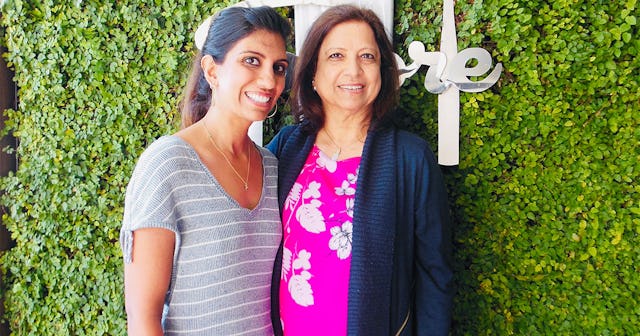Butter Chicken And Other Ways I Remember My Mom

Being the only daughter of immigrant parents, I was taught at a very young age to be consonant with friends at school, with my teachers, and with my parents’ non-Indian friends, basically doing what I needed to outside of the home to blend in. I grew up at a time when being Indian was not cool and exotic. It was different and different was scary — I think more to us than others. My mom dressed me in the newest and coolest clothes from Macy’s, which we could only afford because she worked there. She made sure I only spoke English, and when I would visit her at work she put on a very “American” accent, over-exaggerating her “How are ya?” and “Right on” tag lines she learned from her peers.
Courtesy of Haseena Vaswani
But for some reason when it came to food, my mother could not conform. Our Sunday grocery store trips always included two stops, the Indian market and the “regular” market as mom called it. I often wondered why okra from Ralph’s was not as good as okra from India Sweets and Spices, but I never asked. We would load up on what was needed for a week of breakfast, lunch and dinner. Saturday night was the only time we ate out, at our local Thai restaurant — or every now and then, pizza.
During the week, my mom would come home after hours spent standing on her feet, go straight into the kitchen and whip up fresh subzis (vegetables) and roll out handmade rotis every single night. She didn’t know, nor did she try, any short-cuts that were so popular back then liked canned and frozen vegetables. In fact she didn’t even know they existed and when she discovered them, she was appalled. Instead she tediously, but so lovingly, finely chopped each vegetable, puréed fresh tomatoes, and roasted her own spices. She took leftovers every day for lunch, packed in round steel containers, never using the microwave in the lunch room or venturing out to the food court like most of her colleagues.
Courtesy of Haseena Vaswani
My lunchbox on some days was a sandwich, which appeared like everyone else’s, only on the inside was not lunch meat (mom did not know of that either). It was leftover spicy tandoori chicken or paneer. Some days my lunch was straight up daal and rice in a thermos. I never really thought much of it; I’d eat, ignore any looks or comments, pack up and move on. When my friends would ask “What is that?” My response was “Just some Indian food.” My friends, and I for that matter, ignored the fact that the Indian food in my lunch box was so much a part of me. They also did not realize that my mom cooked their parents pots of butter chicken, that our teachers would also receive appreciation gifts of homemade food from her, and that all these people we had in common relished my mother’s cooking.
I remember trying cold cuts for the first time and then a peanut butter and jelly sandwich (not until college!) and thinking one day, when I have children, this will be their lunch — almost relieved to think that they will know of these foods early on, like I was going to give them something my mother never gave me. Through college, I cooked the only way I knew how: what I had learned from my mom, but also dove into drive-through Taco Bell, Wendy’s, and indulged in burritos “the size of your head.”
Courtesy of Haseena Vaswani
Once I started working and really had to manage my time, I mostly ate out. It was not until my mid to late twenties that the fad of eating all the convenience foods finally wore off, and I started to get back to my roots. I asked my mother for recipes, read up on Ayurveda, and tried to cook with intention. It was then that I realized, it doesn’t matter how you were raised to eat, or what your parents fed you. All that matters is what you put into it, the lessons you’ll be teaching with every turn of a spoon — to those you cook for, even if just for yourself.
Courtesy of Haseena Vaswani
In her later years, my mom started buying frozen rotis, ready-made paneer, and would even use canned tomatoes now and then, but until the day she passed away, she cooked. My mother’s lessons to me were that fresh is always best, to eat for pleasure but more for nourishment (she’d say “power”), and that no meal should lack flavor or spice. I have taken these lessons, along with those my husband grew up with, and infused them into every meal, every snack and every lunch box I prepare.
I tell my daughter what she is eating, how I’ll be putting some in her lunch the next day, and what she can tell people who ask her. She will often come home and tell me the lunch lady asked her again today what is she eating; some days she’s annoyed and some days she’s so proud, but she’s six and she’s trying. I do give my children lunch meat and peanut butter and jelly sandwiches as well, packaged in small steel boxes, of course .
I cook butter chicken for practically anyone I meet, and I recite recipes the way my mom did: “a little of this, maybe a spoonful of that.” Today, after having two kids, I want to give them everything my mother gave me and so little of what she didn’t.